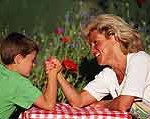 Researchers at England’s University of Cambridge, School of Clinical Medicine, launched a study to build on other research into how the physical activity of mothers and their kids are connected.
Researchers at England’s University of Cambridge, School of Clinical Medicine, launched a study to build on other research into how the physical activity of mothers and their kids are connected.
Parents seem to affect their kids’ physical activities in three ways — by acting as role models, by helping kids be active (by taking them to the park, for instance), and by being active with them. “All three aspects are thought to be important,” Esther van Sluijs, group leader, said, “but it has generally been unclear how directly mother and child’s physical activity are related.”
In the study, the researchers used devices called accelerometers to track 554 children, all 4 years old, and their mothers for as many as seven days. “The more activity a mother did, the more active her child,” van Sluijs noted.
Specifically, for every single minute of moderate-to-vigorous activity that the mother did, her child was more likely to do 10 percent more of a similar level of activity. Those extra minutes add up over time, according to researchers.
“If activity in mothers and children can be encouraged or incorporated into daily activities so that more time is spent moving, activity levels are likely to increase in both,” van Sluijs said. “In return, this is likely to have long-term health benefits for both.”
Another expert focused on the issue of fathers and what role they might play.
“This is a big question not addressed here,” said Leann Birch, a professor at the University of Georgia’s department of foods and nutrition who studies children and obesity. But, she said, research on parenting suggests that fathers tend to engage in more rough-and-tumble and high-action play with kids than mothers.
Also, she said, “some of our own work showed that reported activity by dads was more important than by moms in predicting the activity of daughters, especially in organized sports during later childhood.”
Adapted from an article in Medline Plus.
